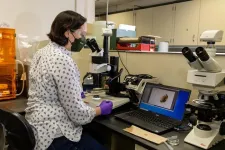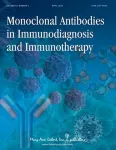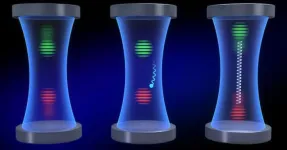(Press-News.org) Scientists at the Department of Energy’s Oak Ridge National Laboratory have developed lubricant additives that protect both water turbine equipment and the surrounding environment.
Each year, roughly 2.47 billion gallons of lubricating oil are consumed in the United States alone for engines and industrial machinery, according to DOE, with about half eventually finding its way into the environment.
While environmentally acceptable lubricants are available, they are not optimized with additives that can greatly improve performance while posing minimal environmental impact if accidentally released. To create nontoxic, biodegradable and high-performing lubricant additives for water power turbines, researchers turned to ionic liquids, or ILs: organic liquid salts that mix well with oil, reduce friction between bearings and gears, and are stable in a range of temperatures.
A team of materials and environmental scientists at ORNL worked together to design, synthesize and test top-candidate ILs of ammonium phosphate and phosphonium phosphate that provide a good mix of properties.
When added to base oils, the ILs demonstrated 50% less friction and a tenfold decrease in equipment wear compared to a commercially available gear oil, while meeting federal standards for environmental toxicity and biodegradability, as described in ACS Sustainable Chemistry & Engineering
The project builds on more than 20 years of IL research at ORNL, including the development of lubricant additives designed to reduce engine wear and boost fuel economy in vehicles.
“Our previous work showed us that you could dramatically increase the performance of lubricants with the addition of just 1% or even a half-percent of ILs,” said ORNL’s Jun Qu, who leads the project and the Surface Engineering and Tribology group at ORNL.
This time around, scientists sought to create a nontoxic additive for use in turbines installed in aquatic environments, generating electricity using waves, tides, ocean and river currents. Although ILs are generally considered less toxic than conventional lubricant ingredients, their impact on the environment has not been closely studied.
“On the environmental side, there are three main factors we care about with these lubricants,” said Teresa Mathews, lead for the Biodiversity and Ecosystem Health group at ORNL. “They have to be highly performing, we don’t want them to be toxic to any aquatic organisms, and if there’s a spill, we don’t want the lubricants to be compounds that last in the environment. We want them to degrade very rapidly.”
Pursuing a cleaner formula
The team first sought to eliminate potential toxic elements such as fluorine and chlorine and metals such as zinc and iron from the candidate ILs. They also focused on creating ILs made up of shorter hydrocarbon chains — chains containing fewer than six carbon atoms — which are generally considered to be less toxic.
“We found a four-carbon chain to be the sweet spot,” Qu said. Going shorter than four carbons resulted in an IL that didn’t mix well with oil and was less thermally stable, he added.
Friction testing was accomplished with metal pieces simulating turbine gears and bearings coated with a lubricant containing the IL. Resulting surface wear of the pieces was characterized using electron microscopy at the Center for Nanophase Materials Sciences, a DOE Office of Science user facility at ORNL.
These particular ILs are fairly straightforward to produce and can be easily scaled up for commercialization, said Huimin Luo, a chemist in ORNL’s Manufacturing Science Division who led the chemical synthesis work.
To determine the additives’ environmental impact, ORNL ecotoxicologist Louise Stevenson conducted toxicity and biodegradability tests in ORNL’s Environmental Toxicology Laboratory, where assessments are routinely conducted for DOE, the Department of Defense and other agencies. Following Environmental Protection Agency protocols, the toxicity tests used Ceriodaphnia, tiny planktonic crustaceans commonly known as water fleas that sit at the bottom of the food chain, have a short life cycle and rapid reproduction rate, and are highly sensitive to environmental conditions.
Tiny plankton provide big insights
The organisms “are like canaries in a coal mine for aquatic toxicity because they are filter feeders and interact with a lot of water,” Stevenson said. “In a seven-day test, we’ll get three to four rounds of reproduction with daily hatching, so we can look for both lethal effects and sublethal effects such as reproductive and growth impacts that have an effect on population survival.”
While the environmentally acceptable lubricant base oils had no effect on the crustaceans, the commercial lubricant additives and two early IL compounds were found to be extremely toxic to the organisms, resulting in 100% mortality within one to three days after exposure. The team’s ultimate designs for short-chain ammonium phosphate and phosphonium phosphate IL additives resulted in 90-100% survival rates after seven days.
The final, top-performing IL-enhanced lubricants were also found to be highly biodegradable compared to standard lubricant additives. Testing involved exposing the compounds to aquatic microbes and then measuring the rate of carbon dioxide production as the microbes broke down the materials.
High-performing, environmentally friendly lubricants designed specifically for marine energy turbines are important for other reasons, including equipment durability. Lubricant technology currently in use for marine turbines was borrowed from wind turbines, which are serviced every six to 18 months, Qu said. But tidal turbines installed in the ocean or rivers are typically designed for service every six years and operate under much harsher conditions.
The project is expected to next focus on further development of IL lubricant additives specifically for use in tidal turbines operating in the ocean and exposed to potential seawater contamination and pressure and temperature extremes.
‘Only at ORNL’
The project highlights the diverse expertise and capabilities assembled at ORNL to address a broad range of economic, environmental and societal challenges, the scientists noted.
“I love to talk about this project when I’m giving tours of the Aquatic Ecology Lab,” Stevenson said. “This is the type of work that can only happen at ORNL, because we have such an interdisciplinary staff here. Jun and Huimin developed a compound, brought it to us for toxicity and biodegradability testing, then we gave feedback and everyone worked iteratively to find the greenest chemical possible.
“Green chemistry is a hot topic, and this is an example of actually doing that and working together between materials scientists and environmental scientists to get at a solution in a collaborative, productive way.”
For information on technology licensing or collaborative research, contact ORNL’s Partnerships Office. The project was funded primarily by the DOE Office of Energy Efficiency and Renewable Energy’s Water Power Technologies Office, as well as DOE EERE’s Vehicle Technologies Office and the DOE and ORNL Technology Innovation programs.
UT-Battelle manages ORNL for DOE’s Office of Science, the single largest supporter of basic research in the physical sciences in the United States. DOE’s Office of Science is working to address some of the most pressing challenges of our time. For more information, visit https://energy.gov/science.
END
New eco-friendly lubricant additives protect turbine equipment, waterways
2024-05-02
ELSE PRESS RELEASES FROM THIS DATE:
Monoclonal Antibodies in Immunodiagnosis and Immunotherapy appoints new Deputy Editor-in-Chief, Andrei Moroz, PhD
2024-05-02
Mary Ann Liebert, Inc., is pleased that Andrei Moroz, PhD, has been appointed the new Deputy Editor-in-Chief of the bimonthly journal Monoclonal Antibodies in Immunodiagnosis and Immunotherapy. Dr. Moroz is joining Cory Brooks, PhD, as part of the senior editorial leadership team for the journal.
Monoclonal Antibodies in Immunodiagnosis and Immunotherapy is a peer-reviewed venue for promoting and sharing research rooted in hybridoma technology. It aims at advancing the understanding of the biology and immunology that underscores the utility of antibodies as diagnostics and therapeutics. The journal publishes ...
Optical pumped magnetometer magnetocardiography as a potential method of therapy monitoring in fulminant myocarditis
2024-05-02
https://www.scienceopen.com/hosted-document?doi=10.15212/CVIA.2024.0031
Announcing a new article publication for Cardiovascular Innovations and Applications journal. Fulminant myocarditis (FM) is associated with high mortality and an unfavorable long-term prognosis. However, noninvasive, rapid diagnostic and monitoring methods for FM are lacking.
This article details the case of a patient diagnosed with FM through a comprehensive assessment involving typical clinical symptoms, laboratory analyses, echocardiographic evidence, and cardiac magnetic resonance (CMR) findings. Before the patient underwent CMR, optical pumped magnetometer magnetocardiography (OPM-MCG) revealed abnormalities characteristic ...
Heart failure registries in Asia – what have we learned?
2024-05-02
https://www.scienceopen.com/hosted-document?doi=10.15212/CVIA.2024.0026
Announcing a new article publication for Cardiovascular Innovations and Applications journal. Heart Failure (HF) is one of the leading problems in cardiology practice today. Acute decompensated heart failure (ADHF) is a significant cause of mortality and morbidity worldwide, and this is more relevant in the Asian subcontinent with a high population burden. Various regional registries in Asia have given us valuable insight into the aetiology and outcomes in this context. Though there are regional differences, it is clear from the review carried out in this paper that HF affects a much younger population. ...
Study helps understand how energy metabolism is regulated at cellular level
2024-05-02
An article published in The Faseb Journal describes a Brazilian study analyzing the correlation between two key energy metabolism regulation processes: the absorption and release of calcium ions by mitochondria, the organelles that generate energy for cells; and autophagy induced by calorie restriction. Autophagy occurs when cells break down and reuse their own cytoplasm.
The study was conducted at the Center for Research on Redox Processes in Biomedicine (Redoxome), a Research, Innovation and Dissemination Center (RIDC) funded by FAPESP and hosted by the University of São Paulo’s Institute of Chemistry ...
Stay active – or get active – to boost quality of life while aging, study suggests to middle-aged women
2024-05-02
Consistent adherence to physical activity guidelines throughout middle-age is associated with a higher health-related quality of life in women, according to a new study publishing May 2nd in the open-access journal PLOS Medicine by Binh Nguyen of University of Sydney, Australia, and colleagues.
The evidence for an association between physical activity and health-related quality of life has been based primarily on cross-sectional studies and short-term randomized controlled trials. Few longitudinal studies have measured physical activity at more than one time point and examined the long-term causal effects ...
*FREE* Friendship-nomination approach identifies key villagers to diffuse health messages
2024-05-02
In experiments in isolated villages in Honduras, researchers evaluated a new strategy for identifying individuals that could be targeted for effective information spreading. Their approach – more effective than random targeting, and also less time-requisite than approaches that require a complete understanding of the relevant social network – could have far-reaching policy implications in lower and middle-income countries. Understanding the structure and function of human social networks has yielded insights for exploiting social ...
Chromosomal 22q11.2 deletion confers risk for severe spina bifida
2024-05-02
Chromosomal 22q11.2 deletions increase risk for meningomyelocele, one of the most severe and common forms of spina bifida, researchers report. According to the findings, this risk is mediated by the loss of Crkl, one of several neural tube expressed genes located on the 22q11.2 deletion interval, and this risk is only partially alleviated by folate supplementation. Meningomyelocele (MM) is a severe type of neural tube defect, which often requires pre- or post-natal surgical repair and can result in a variety of physical and developmental difficulties. Although the incidence of the condition has declined in recent decades, largely due to folic acid (FA) fortification, MM ...
Circadian clocks in the brain and muscles coordinate to support daily muscle function
2024-05-02
Molecular circadian clocks in the brain and muscle tissue cooperate to keep muscles healthy and functioning daily, according to a new study in mice. The findings could provide valuable insight into understanding the roles of circadian disruption in age-associated health issues and potential strategies to protect muscle function in aging individuals. A circadian molecular clock network is crucial for daily physiology and maintaining health. It’s thought that this network – which extends throughout all cells in the body – is hierarchically organized and coordinated by the brain’s suprachiasmatic nucleus (SCN), which receives daily light cues and synchronizes ...
*FREE* The effectiveness of early childhood education programs is scientifically uncertain
2024-05-02
Early care and education (ECE) programs – like Pre-Kindergarten (Pre-K) and Head Start – are widely regarded as effective public investments for reducing income- and race-based achievement gaps and helping children succeed in school with impacts extending well into adulthood. However, in a Policy Forum, Margaret Burchinal and colleagues present recent evidence suggesting that preschool impacts are not unequivocally positive and the science on the overall outcomes of these programs remains unsettled. According to Burchinal et al., more rigorous research is needed to understand how to design early education programs that produce long-term positive ...
Twisting and binding matter waves with photons in a cavity
2024-05-02
Precisely measuring the energy states of individual atoms has been a historical challenge for physicists due to atomic recoil. When an atom interacts with a photon, the atom “recoils” in the opposite direction, making it difficult to measure the position and momentum of the atom precisely. This recoil can have big implications for quantum sensing, which detects minute changes in parameters, for example, using changes in gravitational waves to determine the shape of the Earth or even detect dark matter.
In a new paper published in the Science, JILA and NIST Fellows Ana Maria Rey and James Thompson, ...





